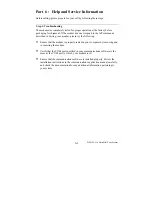
PCMCIA 33.6 Data/FAX/Voice Modem
4-2
What to Expect from Cellular Data Transmissions
Cellular mobility creates some conditions of which you should be aware:
•
Cellular phones use radio frequencies for transmission, and are subject to the
same signal impairments as are other radio devices. Your modem is designed
to overcome this.
•
Because cellular telephones use radio frequencies, they do not do any of the
following:
•
Generate dial tones or busy signals
•
Send ring voltage back to the modem
•
Decode touch tone or pulse dial signals
Your modem is configured to overcome this.
•
A large portion of the cellular voice channel is reserved for out-of-band
signalling, reducing the bandwidth on the cellular network. This can result
in distortion or signal loss. You cannot control this.
•
Voice compression techniques on some cellular networks can cause loss of
bandwidth, resulting in slower data transmission. You cannot control this.
•
The mobile telephone exchange may send a signal over the control channel
commanding the telephone to reduce its transmission power, possibly
resulting in dropped data lines. You cannot control this.
•
The mobile telephone exchange may send messages to, or request
information from, the telephone on the voice channel while the data link is
established. This can temporarily disrupt data communications or cause the
line to be dropped. You cannot control this.
Содержание 84H5162
Страница 1: ......
Страница 6: ...PCMCIA 33 6 Data FAX Voice Modem 1 2 Safety Information...
Страница 7: ...PCMCIA 33 6 Data FAX Voice Modem 1 3 Safety Information...
Страница 8: ...PCMCIA 33 6 Data FAX Voice Modem 1 4...
Страница 22: ......
Страница 46: ......
















































